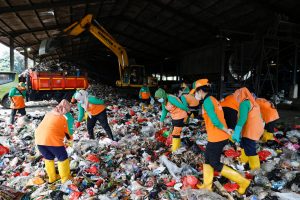Expenditures for environmental protection declined by 4.6% year on year in 2021, data from the Philippine Statistics Authority (PSA) showed.
The statistics agency’s Compendium of Philippine Environment Statistics (CPES) Component 6 showed annual government environmental protection expenditures went down to P25.4 billion last year from P26.6 billion in 2020.
The CPES, an adoption of the United Nations-developed Framework for the Development of Environment Statistics, is a compilation of statistical data gathered from different government agencies. It consists of data on expenditures, regulations, and other activities such as international agreements focusing on the protection of the environment and management of resources.
Expenditures for the protection of biodiversity and landscape rose by 9.7% last year to P11.5 billion. It accounted for 45.1% of the total expenditures for environmental protection.
This was followed by environmental protection not elsewhere classified with P6.5 billion, or 25.7% of the total expenditures. Compared to 2020, expenditures allocated for this sector declined by 4.8%.
Expenditures for waste management, on the other hand, reached P3.3 billion, 13% of the total expenditures. Allocation for this sector was lower by 13.7% in 2021 from the P3.8 billion in 2020.
Meanwhile, spending on pollution abatement amounted to P2.8 billion, while research and development environment protection outlays reached P1.2 billion. These accounted for 11% and 4.9%, respectively, of the total environment protection spending in 2021.
Wastewater management had the lowest share in environmental protection outlays with 0.3% or a total of P80 million. This declined by 96.3% from P2.2 billion in 2020.
CPES also showed the Department of Environment and Natural Resources had an annual budget of almost P18 billion in 2021, 4.8% lower than the budget allocated in 2020.
Number of staff or positions per plantilla showed that there were 16,379 staff positions in 2021, slightly higher compared with the 16,354 in 2020.
INTEREST UP AMONG YOUTH
Meanwhile, among the programs under the Philippine Standard Classification of Education, environmental science logged the highest number of enrolled students in the country, with 57,876, followed by forestry (57,073), and environmental planning/management (14,080).
Other programs included environmental and sanitary engineering with 10,624 enrolled students; environment and natural resources management (1,735); environmental education (115); and natural resources conservation (7).
Figures are based on the submission of higher education institutions, which includes pre-baccalaureate up to doctoral programs to the Commission on Higher Education.
Budget allocation for environmental education last year amounted to P1.90 million, 1.8% higher than P1.86 million in 2020.
CLIMATE CHANGE SPENDING DOWN
The CPES also provided data on the climate change expenditures by National Climate Change Action Plan (NCCAP). Total climate change expenditures amounted to P181.9 billion with adaptation at P173.6 billion and mitigation at P8.3 billion.
Expenditures for climate change declined by 21.9% last year from P232.8 billion previously.
Broken down, NCCAP’s strategic priorities showed water sufficiency had the highest expenditure with a total of P132.3 billion, 8.3% lower than the P144.3 billion in the prior year.
This was followed by food security with P22.4 billion; sustainable energy (P12.4 billion); ecosystem and environmental stability (P10.4 billion); climate smart industries and services (P2.7 billion); knowledge and capacity development (P881.9 million); human security (P693.8 million); and cross-cutting (P28 million).
The PSA noted that for the current CPES Component 6, 18 statistics were compiled out of the 50 identified indicators. — Abigail Marie P. Yraola
